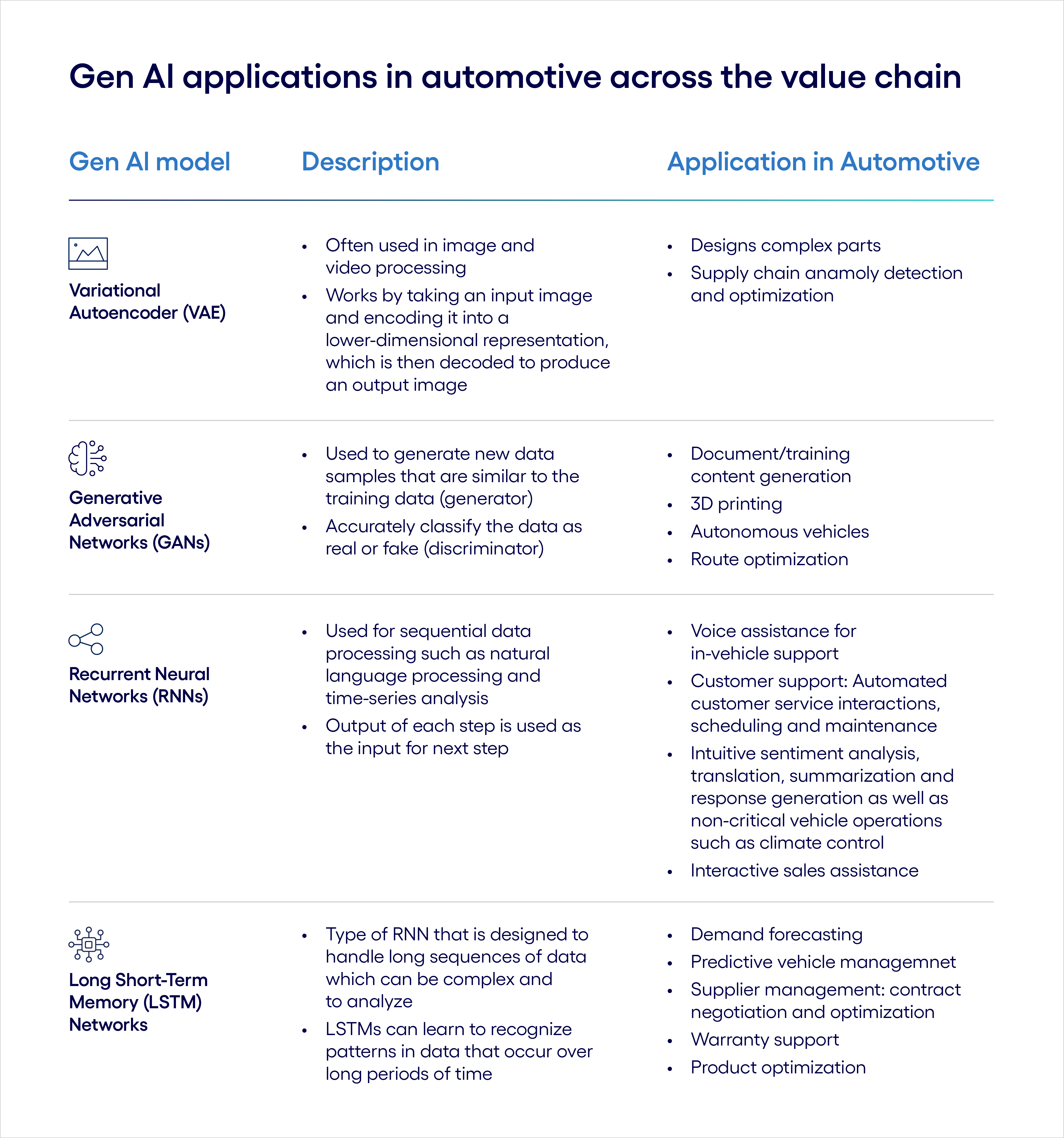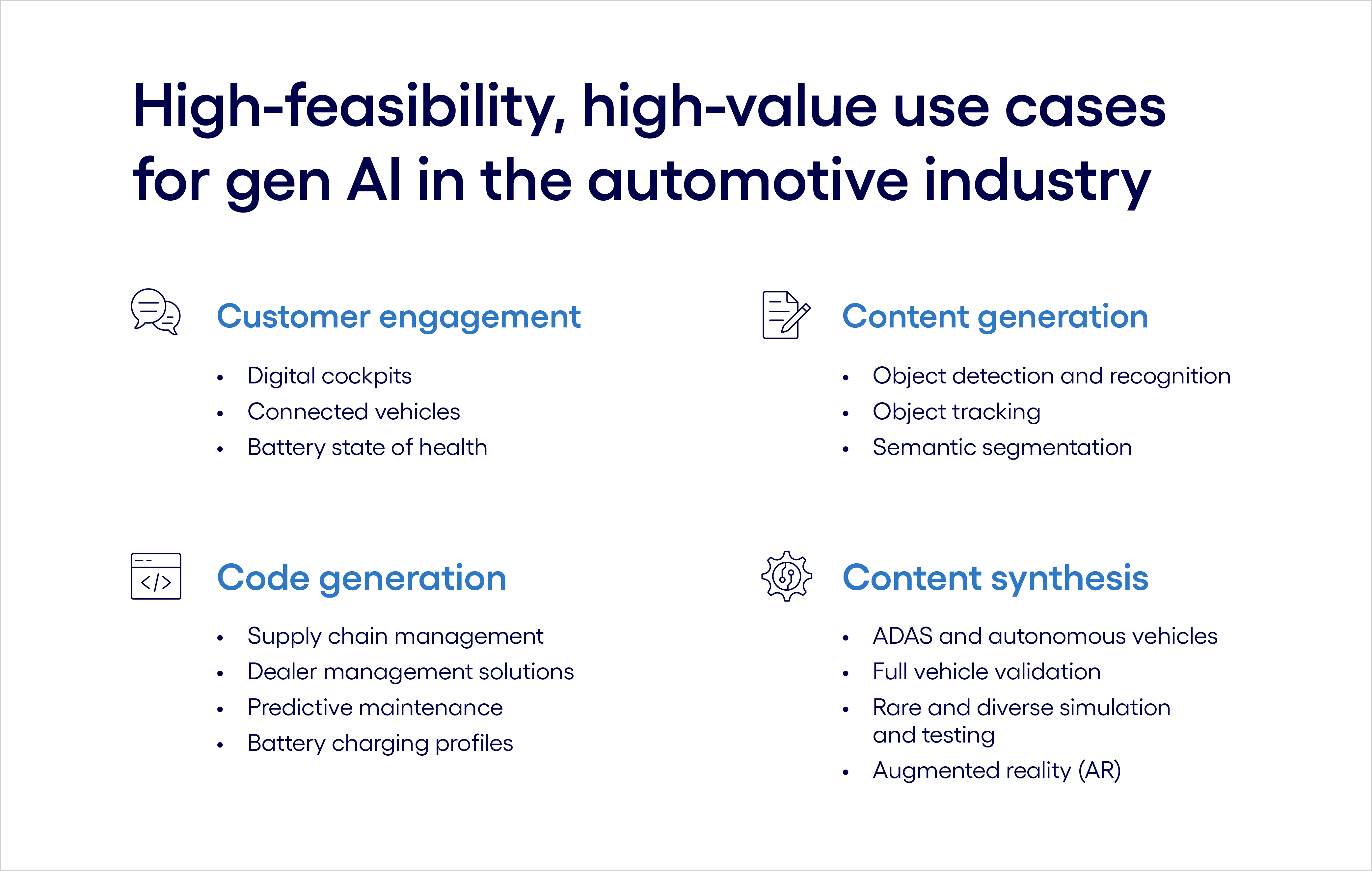June 5, 2024
Five guiding principles for deploying gen AI in automotive
By focusing on feasibility and value, OEMs can build a track record of success with their AI investments.
They say you can’t please everyone, but generative AI has the auto industry questioning the maxim. When a technology makes manufacturers, sellers, and buyers all feel like winners, it’s time to invest.
And every moment spent waiting will cost dearly—generative AI has brought AI to an inflection point. The “run your business and apply AI to help” mindset that once held sway is gone; OEMs are now investigating ways to embed AI deeply in their strategies.
The undeniable opportunity for automotive
According to Statistica, the generative AI market will show a compound annual growth rate of 24.4% between now and 2030, resulting in a market volume of $207 billion by 2030.
The automotive industry is poised to drive its fair share of that growth due to generative AI’s potential to help address changing consumer behavior, cost pressures, labor shortages, and disruption from software-based vehicle design and EV adoption.
The top AI models that address these pressures (as well as wide-ranging applications across the value chain) are shown in Figure 1.
Regardless of where a company stands today in its generative AI journey, the technology’s overwhelming potential stems from its ability to not only improve the experience in and around the vehicle, but also to make overall vehicle ownership and production safer, more predictable, and less stressful.
Figure 1
Leading OEMs have already invested in use cases around in-car driving assistants, Advanced Driver Assistance Systems (ADAS), and research and development/design generation:
- GM is enhancing R&D by using generative AI-powered design to create lighter parts
- Mercedes has embedded generative AI in its cars’ voice assistant to improve the driving experience
- BMW, Toyota and Tesla are all leveraging the technology for design of overall vehicle aesthetics, part design, part specifications, and testing these designs against driving scenarios
This is just the beginning. We believe that if implemented wisely, generative AI will benefit every link in the value chain: the car-buying and ownership experience, the driver and passenger interface, service and maintenance, R&D, and the supply chain.
Four early areas for generative AI in automotive
After discussions with leaders at OEMs, as well as helping clients with pilot programs, we’ve identified high-feasibility, high-value use cases in which leaders in the automotive industry should apply generative AI. These use cases are shown in Figure 2.
Figure 2
This is only a high-level look at the potential applications. The use cases in the graphic above all have their own strong set of sub-categories for possible implementations. This is where each automaker must marry the pilot use cases with company vision, goals, and differentiators.
Five guiding principles for deploying a gen AI strategy
To strike the right balance between risk and demand in generative AI use case deployment, OEMs should follow these guiding principles:
1. Start at the low-risk/high-demand intersection. Begin with use cases that have high demand and minimal risk (see our list above), to understand the capabilities and limitations of large language models within the automotive business context.
2. Create and curate the right mix tools and platforms. Several existing tools and platforms have integrated AI into their products—Salesforce Einstein and Microsoft 365 Copilot are just two examples. OEMs must invest in additional, complementary tools that span essential applications to fully unlock the potential of generative AI.
3. Collaborate with a diverse group of stakeholders. Generative AI requires a truly diverse set of skills to be implemented successfully. To unlock the technology’s potential, organizations should collaborate with customer and dealer representatives, data scientists, and legal experts in addition to IT specialists.
4. Use iterative deployment. Adopt an iterative approach with feedback loops to continuously evaluate the performance, impact, and risks associated with LLMs.
5. Upskill with proactive training and support. Develop a comprehensive training program to upskill the workforce on generative AI. This is crucial in such a new field. Today, the skills required to activate a strategy simply do not exist at scale.
Ground zero: build your gen AI ecosystem
It is critical that automakers select the right partner as they embark on a generative AI journey. Any organization you partner with should bring insights into your business from other OEMs, tier 1 suppliers, dealers, and automotive technology companies.
Keeping in mind how critical generative AI will be, Cognizant has invested in a Neuro AI platform that brings together multiple features spanning areas such as IT services, automation and gen AI, spearheading proof of concepts for multiple clients.
We’re here to offer you practical and unique solutions to today’s most pressing technology challenges. Across industries and markets, get inspired today for success tomorrow.
Latest posts
Related posts
Get actionable business Insights in your inbox
Sign up for the Cognizant newsletter to gain actionable AI advice and real-world business insights delivered to your inbox every month.


















